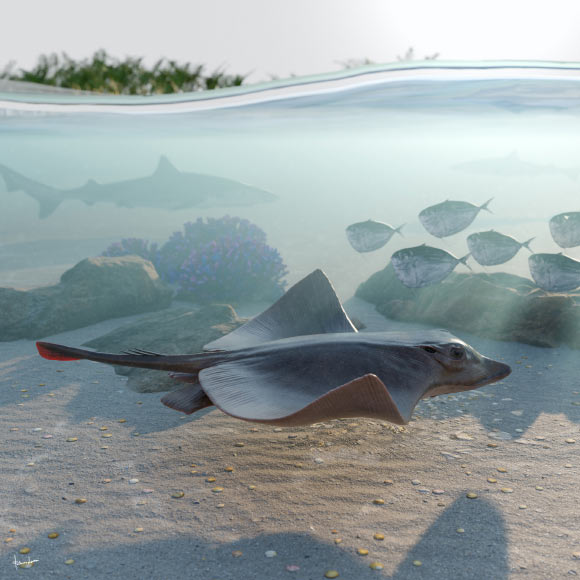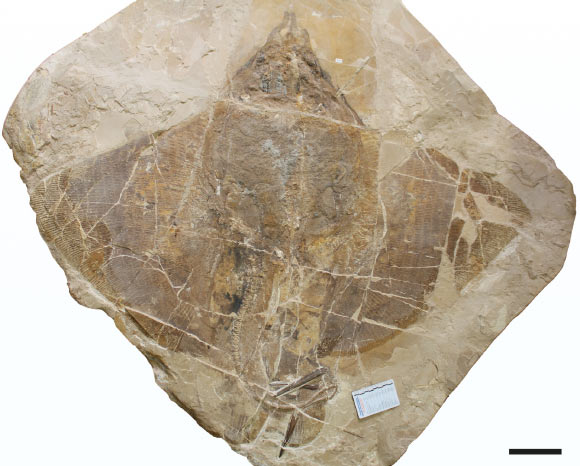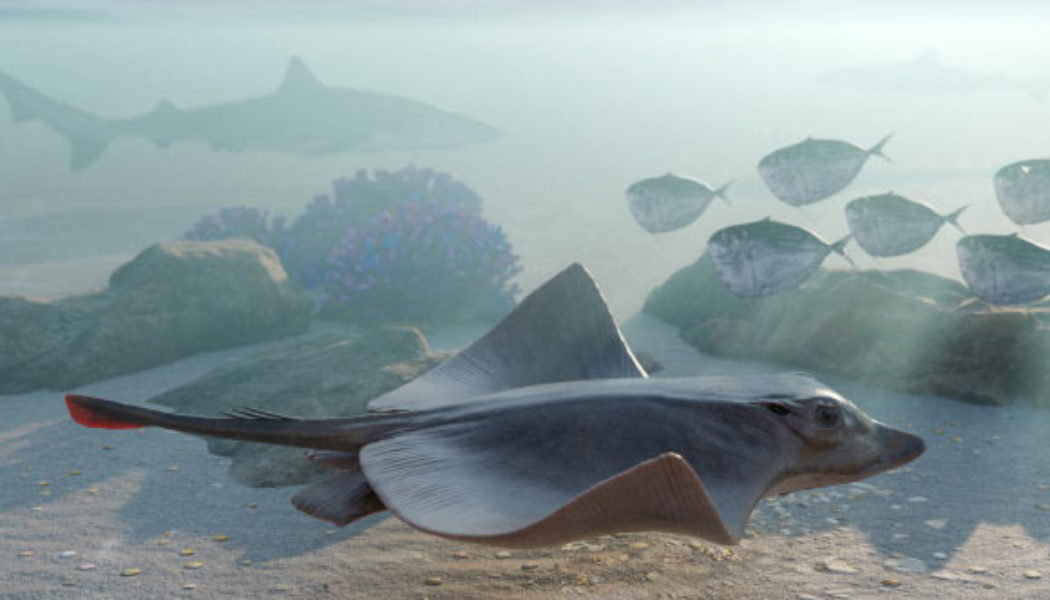Dasyomyliobatis thomyorkei is intermediate between the ‘rajobenthic’ and more derived ‘aquilopelagic’ stingrays, supporting the hypothesis that the aquilopelagic body plan arose in association with the evolution of durophagy (specializations for crushing or cracking hard prey) and pelagic lifestyle from a benthic, soft-prey feeder ancestor.

Life reconstruction of Dasyomyliobatis thomyorkei swimming in the marine tropical shallow waters of the western Tethys about 50 million years ago. Image credit: Fabrizio Lavezzi.
“Rays (Batoidea) are a diverse group of cartilaginous fishes whose body plan is adapted for a benthic lifestyle,” said University of Turin’s Professor Giorgio Carnevale and his colleagues.
“While guitarfishes and electric rays use their tail for locomotion, skates and stingrays (Myliobatiformes) use their pectoral fins for both locomotion and feeding.”
“Stingrays show the highest morphological disparity; most species possess a rounded to rhombic, soft and flexible pectoral disc supported by radials with four-chain catenated calcification that allow undulatory swimming in which multiple waves propagate along the pectoral-fin margin.”
“These features, coupled with a mostly negative fin-ray distribution index and low pectoral-fin aspect ratio, are particularly efficient for swimming at low speed above the bottom.”
“These stingrays also use their pectoral disc to constrain and press prey against the substrate (tenting behavior). Prey are then grasped and processed through batteries of numerous, small, holaulacorhizous teeth of orthodont or osteodont histotype, forming the so called crushing-type dentition.”
“This feeding apparatus is not designed for durophagy but allows benthic stingrays to grasp, suck and chew, giving them the ability to consume a large variety of soft prey mainly including bony fishes, annelids and thin-shelled crustaceans.”
“This body plan represents the generalized ‘rajobenthic’ ecomorphotype, making benthic soft-prey feeder stingrays among the most successful colonizers of shallow-water habitats in freshwater and marine environments.”
“Another group of stingrays, including eagle rays, cownose and devil rays, adopted a pelagic/benthopelagic lifestyle using an oscillatory swimming mode,” the paleontologists said.
“They belong to the so called ‘aquilopelagic’ ecomorphotype, as they exhibit a different body plan, with head protruding anterior to a pectoral disc formed by laterally expanded wing-like fins resulting in high pectoral-fin aspect ratio, stiffened by radials with crustal calcification and cross-bracing, and always having a positive pectoral-fin-ray distribution index and often a compagibus laminam.”
“This combination of features reduces drag whilst increasing lift and thrust generation, allowing active underwater flight in pelagic/benthopelagic environments.”

Dasyomyliobatis thomyorkei from the Eocene of Monte Bolca, Italy. Scale bar – 10 cm. Image credit: Marramà et al., doi: 10.1111/pala.12669.
In their research, Professor Carnevale and co-authors analyzed the fossilized remains of a previously unknown genus and species of stingray that shows a mosaic of ‘rajobenthic’ and ‘aquilopelagic’ features.
Named Dasyomyliobatis thomyorkei, the marine animal lived 50 million years ago during the Eocene epoch.
The fossil was discovered in 2020 at the site of Pesciara in the Konservat-Lagerstätte of Bolca, northeastern Italy.
“Dasyomyliobatis thomyorkei is represented by a single, nearly complete and articulated skeleton preserved in two limestone slabs as part and counterpart,” the researchers said.
“Its good preservation allowed the recognition and description of several skeletal and dental characters, which are useful to distinguish and separate the species from any other known living and fossil stingray.”
“The specimen represents an adult female characterized by disc width of 99.9 cm and a total length (from the tip of cephalic lobes to the tip of tail) of 106.1 cm.”
Dasyomyliobatis thomyorkei possesses a unique mosaic of plesiomorphic traits typical of benthic soft-prey feeder stingrays (the rajobenthic ecomorph) and derived characters typical of durophagous pelagic stingrays (the aquilopelagic ecomorph), which have never been found in any fossil or living stingray.
The species also represents a new stingray family, named Dasyomyliobatidae.
“Dasyomyliobatis thomyorkei is a representative of a new stingray family with unique hybrid dentition and pectoral-fin morphology that allowed the shift from undulatory to oscillatory swimming, and to exploit a variety of prey (from soft-bodied to hard-shelled organisms),” the authors said.
“The evolutionary origin of durophagy and pelagic lifestyle was achieved through gradual transformation of morphological traits at least since the early Late Cretaceous.”
“Cephalic lobes were already present in a stingray without crustal calcification, cross-bracing, or compagibus laminam corroborating the hypothesis that they originated before the shift toward exclusive oscillatory locomotion and occupation of pelagic environments.”
“The phylogenetic analyses highlight that evolutionary modifications of the dentition related to a shift toward extreme durophagy seem to covariate with the evolution of traits of pectoral skeleton related to a shift toward a pelagic lifestyle, possibly reflecting high level of integration.”
The findings were published in the journal Palaeontology.
_____
Giuseppe Marramà et al. 2023. The evolutionary origin of the durophagous pelagic stingray ecomorph. Palaeontology 66 (4): e12669; doi: 10.1111/pala.12669









